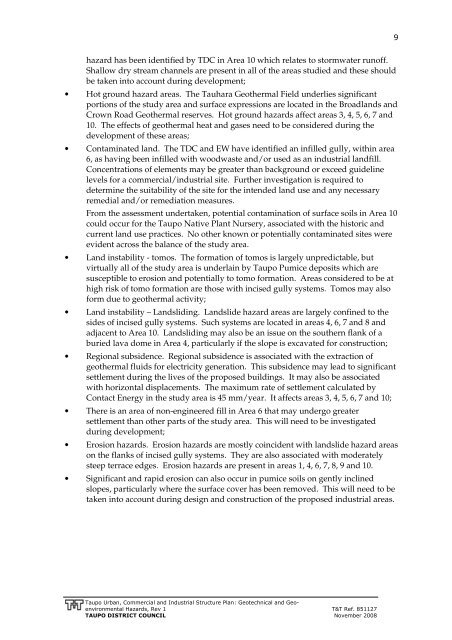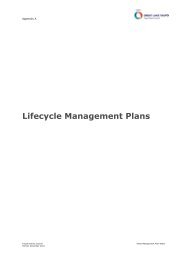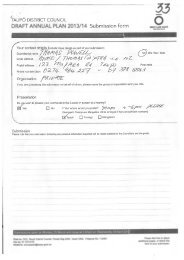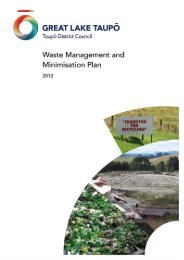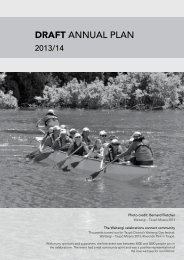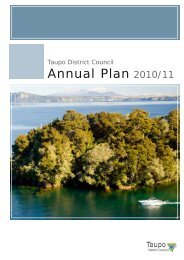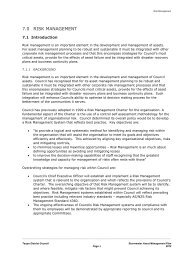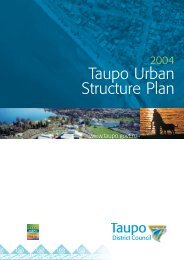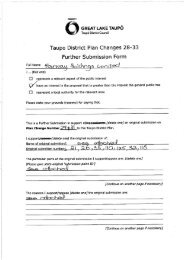Geotechnical Assessment - Taupo District Council
Geotechnical Assessment - Taupo District Council
Geotechnical Assessment - Taupo District Council
You also want an ePaper? Increase the reach of your titles
YUMPU automatically turns print PDFs into web optimized ePapers that Google loves.
hazard has been identified by TDC in Area 10 which relates to stormwater runoff.<br />
Shallow dry stream channels are present in all of the areas studied and these should<br />
be taken into account during development;<br />
• Hot ground hazard areas. The Tauhara Geothermal Field underlies significant<br />
portions of the study area and surface expressions are located in the Broadlands and<br />
Crown Road Geothermal reserves. Hot ground hazards affect areas 3, 4, 5, 6, 7 and<br />
10. The effects of geothermal heat and gases need to be considered during the<br />
development of these areas;<br />
• Contaminated land. The TDC and EW have identified an infilled gully, within area<br />
6, as having been infilled with woodwaste and/or used as an industrial landfill.<br />
Concentrations of elements may be greater than background or exceed guideline<br />
levels for a commercial/industrial site. Further investigation is required to<br />
determine the suitability of the site for the intended land use and any necessary<br />
remedial and/or remediation measures.<br />
From the assessment undertaken, potential contamination of surface soils in Area 10<br />
could occur for the <strong>Taupo</strong> Native Plant Nursery, associated with the historic and<br />
current land use practices. No other known or potentially contaminated sites were<br />
evident across the balance of the study area.<br />
• Land instability - tomos. The formation of tomos is largely unpredictable, but<br />
virtually all of the study area is underlain by <strong>Taupo</strong> Pumice deposits which are<br />
susceptible to erosion and potentially to tomo formation. Areas considered to be at<br />
high risk of tomo formation are those with incised gully systems. Tomos may also<br />
form due to geothermal activity;<br />
• Land instability – Landsliding. Landslide hazard areas are largely confined to the<br />
sides of incised gully systems. Such systems are located in areas 4, 6, 7 and 8 and<br />
adjacent to Area 10. Landsliding may also be an issue on the southern flank of a<br />
buried lava dome in Area 4, particularly if the slope is excavated for construction;<br />
• Regional subsidence. Regional subsidence is associated with the extraction of<br />
geothermal fluids for electricity generation. This subsidence may lead to significant<br />
settlement during the lives of the proposed buildings. It may also be associated<br />
with horizontal displacements. The maximum rate of settlement calculated by<br />
Contact Energy in the study area is 45 mm/year. It affects areas 3, 4, 5, 6, 7 and 10;<br />
• There is an area of non-engineered fill in Area 6 that may undergo greater<br />
settlement than other parts of the study area. This will need to be investigated<br />
during development;<br />
• Erosion hazards. Erosion hazards are mostly coincident with landslide hazard areas<br />
on the flanks of incised gully systems. They are also associated with moderately<br />
steep terrace edges. Erosion hazards are present in areas 1, 4, 6, 7, 8, 9 and 10.<br />
• Significant and rapid erosion can also occur in pumice soils on gently inclined<br />
slopes, particularly where the surface cover has been removed. This will need to be<br />
taken into account during design and construction of the proposed industrial areas.


